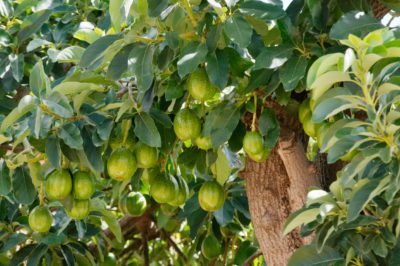Avocados tree
(Avocados tree)

Description
The avocado (Persea americana) is a tree, long thought to have originated in South Central Mexico, classified as a member of the flowering plant family Lauraceae. The fruit of the plant, also called an avocado (or avocado pear or alligator pear), is botanically a large berry containing a single large seed known as a "pit" or a "stone". Avocados are commercially valuable and are cultivated in tropical and Mediterranean climates throughout the world. They have a green-skinned, fleshy body that may be pear-shaped, egg-shaped, or spherical. Commercially, they ripen after harvesting. Avocado trees are partially self-pollinating and are often propagated through grafting to maintain a predictable quality and quantity of the fruit. A typical serving of avocado (100 g) is moderate to rich in several B vitamins and vitamin K, with good content of vitamin C, vitamin E and potassium (right table, USDA nutrient data). Avocados also contain phytosterols and carotenoids, such as lutein and zeaxanthin. Avocados have diverse fats. For a typical avocado: About 75% of an avocado's energy comes from fat, most of which (67% of total fat) is monounsaturated fat as oleic acid. Other predominant fats include palmitic acid and linoleic acid. The saturated fat content amounts to 14% of the total fat. Typical total fat composition is roughly: 1% ω-3, 14% ω-6, 71% ω-9 (65% oleic and 6% palmitoleic), and 14% saturated fat (palmitic acid).
Taxonomic tree:







